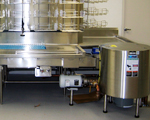We were recently called in to assist in addressing a noise issue that was the result of a university’s desire to be more “green”. In this case, we were asked to assess the noise produced in the dish wash room of a university student union. This blog is the second of a two-part post about student union acoustics, and you may want to read the first blog on College Campuses and Student Union Acoustics before continuing.
I arrived at the student union and was guided by the project architect to the source of the noise. The source was a “pulper.” Although these alternatives to the basic garbage disposal have existed for decades, they are gaining in popularity because they allow for disposal of food waste in a more environmentally friendly manner and they reduce water usage. The pulper is one part of a two part system for disposing of food waste. Food scraps are washed to the end of a trough, where they enter the pulper, kind of a garbage disposal on steroids. The pulper measures several feet in diameter and sits on the dish wash room floor. Blades in the pulper grind the tex-mex casserole, chicken bones, and other scraps and mix them with water to create a slurry. This slurry is pumped to another room where the “extractor” is located. The extractor dehydrates the slurry, creating pellets of solid waste that can be shipped for disposal, and circulating the recycled water back to the dish wash room to create more slurry.
We all know how much noise our household garbage disposals produce. The pulper is similar, only much larger, and connected to a slurry pump and piping that has the potential to carry vibration and noise throughout the entire building. And that is exactly what happened. This particular pulper caused noise levels of 83 dBA at the nearest worker position, three feet away. Noise at the worker position, however, was not even the cause of the complaints. The pulper could be heard in the nearby offices, in the spaces on the floor above, and out in the dining room.
Noise problems on college campuses can become a big deal, affecting everyone in the building. If you are considering installing a pulper, be sure that someone reviews the installation design. Design considerations such as slurry pump location, slurry and recirculation piping routes through the building, vibration isolation mounts, flexible pipe connectors, and the sound level produced by the grinding mechanism all need to be addressed by an acoustical engineer to ensure that the pulper is a benefit to the outdoor environment without being a source of noise pollution for the indoor environment. Otherwise you might create a slurry of noise and vibration to go with the tex-mex casserole and french fries.
